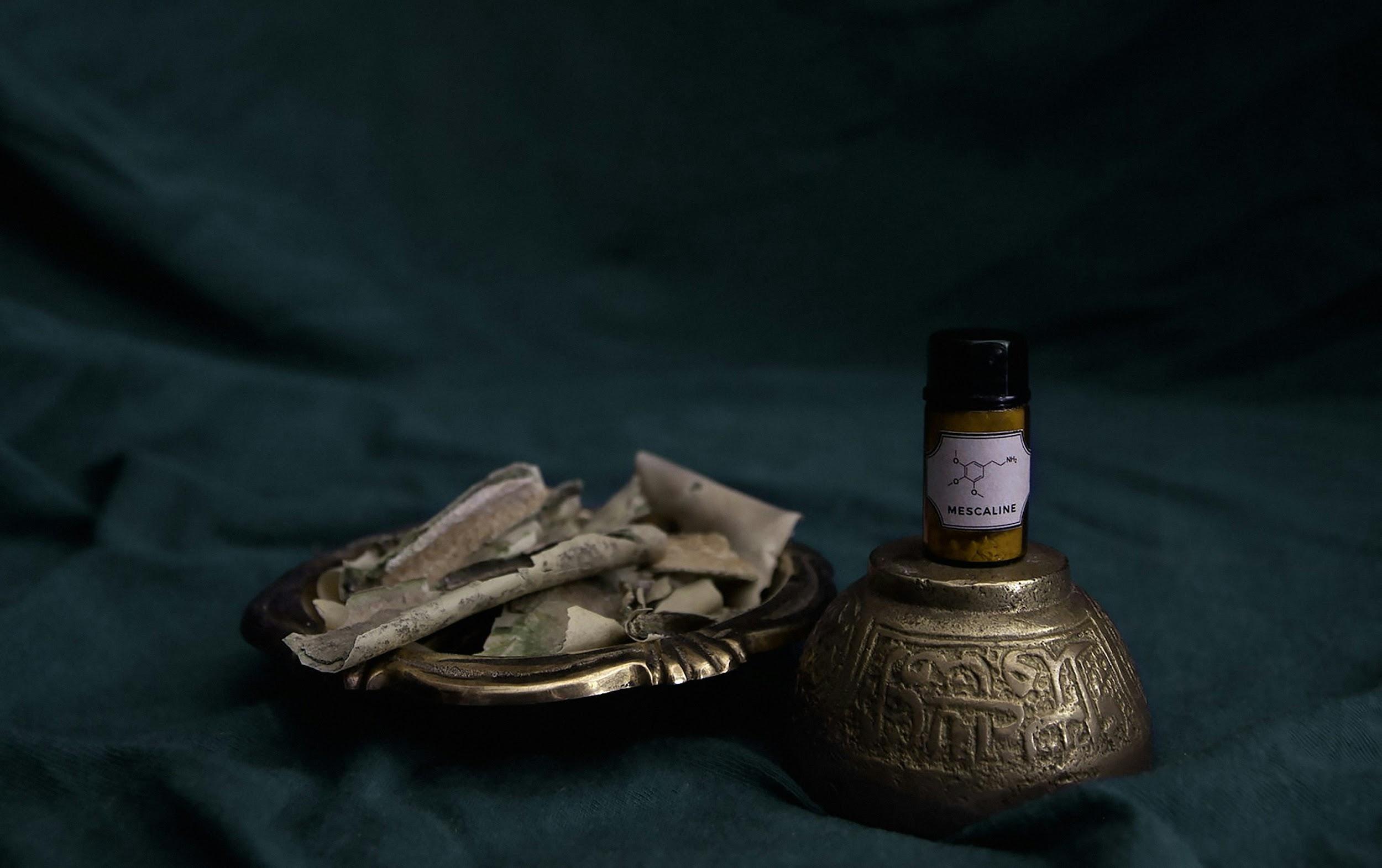Psychedelics have fascinated humans for thousands of years. From ancient rituals in deep jungles to modern therapy rooms, these substances have played a key role in our history. Today, there’s a resurgence of interest in their benefits. This article will take you on a journey through the ages, exploring how psychedelics have been used and their impact on culture and medicine.

Source: https://unsplash.com/photos/gold-and-black-bottle-on-gold-round-tray-LM0MreiLHEg
Photographer: prettydrugthings
Ancient Origins and Uses of Psychedelics
Psychedelics have been a part of human culture for thousands of years. Let’s explore how different ancient civilizations used these substances in their rituals and daily lives.
Shamanic Practices in the Amazon
Imagine indigenous tribes in the Amazon gathering under the stars to drink a brew called ayahuasca. This powerful concoction, made from jungle plants, was used by shamans to connect with the spirit world. It wasn’t just about visions; it was about healing and guidance. The shamans believed that ayahuasca allowed them to communicate with spirits, gain insight into illnesses, and solve community problems.
Mesoamerican Civilizations
In Mesoamerica, the Aztecs and Mayans revered psilocybin mushrooms, often calling them “flesh of the gods.” These mushrooms were central to their religious ceremonies. They believed the mushrooms could open doors to divine realms and provide wisdom from their gods. The rituals involving these mushrooms were deeply spiritual, often involving chanting, dancing, and other forms of worship.
The Eleusinian Mysteries of Ancient Greece
In ancient Greece, the Eleusinian Mysteries were secret rituals held for nearly two thousand years. Participants drank a potion called kykeon, which is thought to have contained psychoactive substances. This ritual promised enlightenment and a glimpse of the afterlife. The exact ingredients of kykeon remain a mystery, but its effects were profound, offering participants a transformative experience.
These ancient practices show that psychedelics were deeply woven into the fabric of these cultures. They were not just for recreation; they were sacred tools for understanding life and the universe.
Today, you can see a new wave of interest in these ancient substances. Platforms like https://newphoria.co are bringing this age-old wisdom to the modern world, offering a range of products like shrooms, LSD, DMT, and Moon Edibles. This resurgence ties us back to our roots, reminding us of the profound connections our ancestors sought through psychedelics.
The Mid-20th Century Renaissance
The mid-20th century was a significant turning point in the history of psychedelics. This era saw the rediscovery and popularization of these substances, leading to a Cultural Revolution and a renewed scientific interest.
Discovery of LSD
In 1938, Swiss chemist Albert Hofmann made a groundbreaking discovery. While working with ergot, a fungus that grows on rye, he synthesized lysergic acid diethylamide (LSD). Hofmann’s ingestion of LSD in 1943 led to the first recorded acid trip, opening the door to a new world of psychedelic experiences. His discovery spurred scientific curiosity and initial research into the potential benefits and mind-altering properties of LSD.
Early Scientific Research
Following Hofmann’s discovery, the 1950s and early 1960s witnessed a surge in scientific research on psychedelics. Psychiatrists and psychologists explored the use of LSD and other psychedelics in treating mental health conditions such as depression, anxiety, and addiction. Studies showed promising results, suggesting that psychedelics could facilitate profound psychological insights and emotional breakthroughs.
The Counterculture Movement
The 1960s brought psychedelics into the mainstream, largely due to their association with the counterculture movement. Figures like Timothy Leary, a former Harvard psychologist, advocated for the use of LSD as a tool for personal and societal transformation. The famous phrase “Turn on, tune in, drop out” encapsulated the spirit of the era, encouraging people to explore altered states of consciousness.
Psychedelics became symbols of rebellion against the established social order, influencing music, art, and literature. The Beatles, for instance, experimented with LSD and reflected their experiences in their music, contributing to the cultural shift.
Backlash and Legal Restrictions
However, the widespread use of psychedelics also led to a backlash. Concerns about their safety and sensationalized media reports resulted in a moral panic. By the late 1960s, many governments, including the United States, classified psychedelics as illegal substances, halting much of the scientific research and criminalizing their use.
Despite the legal restrictions, the mid-20th century renaissance left a lasting impact. The initial research laid the groundwork for the current resurgence of scientific interest in psychedelics.
Psychedelics and Modern Therapy
Advances in research and changes in societal attitudes are paving the way for psychedelics to be recognized and integrated into mainstream therapy.
Resurgence of Scientific Research
Recently, rigorous scientific studies have reignited interest in psychedelics. Researchers are exploring their potential to treat various mental health conditions, including PTSD, depression, anxiety, and addiction. Clinical trials have shown promising results, with many patients experiencing significant improvements after psychedelic-assisted therapy.
Studies involving substances like psilocybin (found in magic mushrooms) and MDMA (commonly known as ecstasy) have fostered deep emotional breakthroughs and lasting positive changes. These findings are helping to shift public perception and reduce the stigma surrounding psychedelics.
Legal and Regulatory Changes
As the scientific evidence grows, so does the push for legal and regulatory changes. Several countries and states are beginning to reconsider their stance on psychedelics. For example, Oregon and Colorado in the United States have decriminalized psilocybin and established frameworks for its therapeutic use. These changes reflect a broader trend toward recognizing the potential benefits of psychedelics and creating safe, controlled environments for their use.
Integration into Wellness and Self-Discovery
Beyond clinical settings, psychedelics are also being integrated into wellness and self-discovery practices. The concept of microdosing—taking sub-perceptual doses of psychedelics—has gained popularity for its reported benefits, such as
- enhanced creativity,
- improved mood and
- increased focus.
Many individuals are incorporating microdosing into their daily routines as a tool for personal development.
Moreover, guided psychedelic experiences are becoming more common in wellness retreats and spiritual journeys. These experiences, often supervised by trained facilitators, provide a safe and supportive environment for individuals to explore their consciousness.
The Future of Psychedelic Therapy
The future of psychedelic therapy looks promising. As research continues to validate the therapeutic potential of these substances, more mental health professionals are likely to incorporate them into their practice.
Psychedelic-assisted therapy could become a standard treatment option for conditions that are currently difficult to manage with traditional methods.
Additionally, the addition of psychedelics into wellness and self-discovery practices suggests a broader acceptance and understanding of their benefits.
Conclusion
Psychedelics have a rich history and a promising future. Their journey from ancient rituals to modern therapy shows their possible power to heal and transform. As we embrace their potential, they can help us better understand ourselves and the world.



